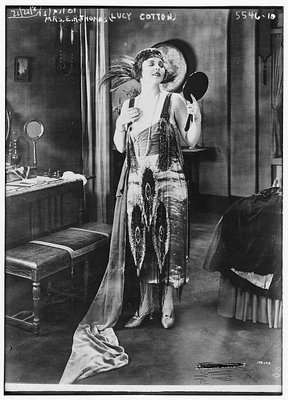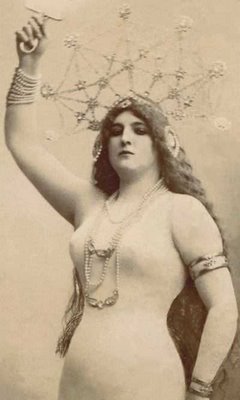
Aimee Crocker (1863-1941), born Sacramento, CA, was an heiress to gold and railroad fortunes and a daughter of Judge Edwin B. Crocker (1818-1875), legal counsel for the Central Pacific Railroad, Justice of the California Supreme Court in 1865 and founder of the Crocker Art Museum, the longest continuously operating art museum in the West. Her father was a brother of Charles Crocker, one of the “big four” California railroad barons.
The family embarked on a grand European tour from 1869 to 1871 then returned to Sacramento to move into the mansion that had been built for them during their journey. Aimee (originally Amy) married five times beginning in 1887. She wrote of her family in her 1937 memoirs, Without Regret, “The Crocker family needs neither introduction nor comment. For those who never read the papers I might say that we were exceedingly wealthy.”
In her teens she was infatuated with several suitors in her first trip abroad. She became engaged to one, a German prince in uniform, after a relationship of one month. She broke the engagement and later wrote of the Prince, “I recall that he did not commit suicide.” She was retrieved from Europe by her mother after presentation at court in Dresden. Back at home, two friends, R. Porter Ashe and Harry Gillig, played a game of poker for her hand and Ashe won with four aces. She married him in 1887 and divorced him one year later. Aimee then chartered a yacht and sailed to Hawaii having met its King, David Kalakaua, in Europe. She remained there almost a year and the King gave her her own island where she was named Princess of its 300 inhabitants.
Returning to San Francisco, she then married Harry Gillig who had earlier lost her hand in the poker game. That marriage, too, ended in divorce. Traveling abroad years later with her daughter, Gladys Ashe, she met two brothers, Jackson and Powers Gouraud. She married Jackson Gouraud and he died several years later. Her daughter Gladys (born 21 November 1885) married his brother Powers Gouraud (thus becoming her mother's sister-in-law) and they also divorced.
On 11 June 1914 Aimee married Prince Alexandre Miskinoff, a Russian nobleman. They separated in 1915 and he divorced her the next year when she contested the suit. He alleged cruel and inhuman treatment as well as desertion and that her actions had made him ill. One of his written charges was that, although he "always behaved in a calm and respectful manner," toward his wife she made great scenes "and arrogantly claimed that her great fortune gave her the privilege to abuse her husband." Her reply was that her husband had become infatuated with a 15-year old girl in her family and that he had misled her prior to their marriage concerning his social standing. The strangest allegation in the suit was that a baby girl was born to the couple on 11 April 1915, a charge his wife denied. Miskinoff replied that he had a letter in his wife's own hand announcing the baby's birth but that his wife immediately left their home at the Hotel McAlpin with the baby because she did not want her daughter from an earlier marriage to know of the child. He alleged that his wife then kept the baby at the Hotel Endicott in the charge of nurses. He stated that he purchased a baby carriage for $80 and for several weeks proudly pushed his daughter around the sidewalks near the Hotel but his wife then became jealous of his attentions to their daughter. He asked for visitation rights to the child but his wife continued to deny her existence and the divorce was granted.
On 22 September 1925 in Paris Aimee married Prince Mstislav Galitzine, Count Ostermann of Russia, born Kiev 21 January 1899, died Paris 28 February 1966. They were divorced in 1927 in Paris when she charged infidelity. Opposing the suit Prince Galitzine said that their marriage “was purely a commercial one, animated by the American woman's desire to be a Princess,” adding that he “married for a financial settlement on condition that the union be one in name only." After their 1927 divorce he remarried a Frenchwoman and had a daughter and Aimee retained the name Princess Galitzine.
She later became very active socially in New York City and had her gowns designed in Paris. While in Java she "wore the native costume and lived in a native hut." During her stay in Japan she lived in a paper house. While there a young British officer reportedly stole for her a sacred Buddha from a temple and "the affair was hushed up." She died at 78 at the Hotel Savoy Plaza in NYC in 1941. Her daughter, Gladys C. Ashe, died in Santa Barbara in 1947 having lived in Beaumont, France, at her Chateau de Baudiment and left a son, Gerald Morgan Russell.



